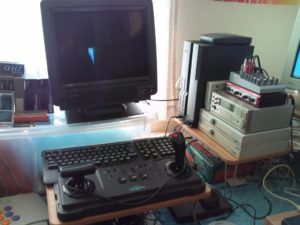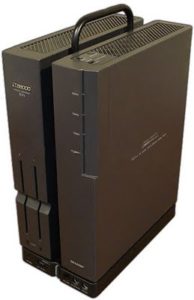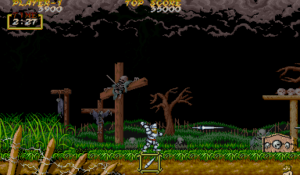Best Games Rooms, Games Rooms
Superdeadite and the ultimate X68000

So far, our best games rooms have focused on users with a wide collection of systems, but in this article we’re featuring a setup that focuses on just one machine. While the owner of this setup, videogame collector and gamer Superdeadite, owns several interesting systems, we decided to focus on his exceptional Sharp X68000 gaming setup.
The X68000 computer is little known here in the west. Released in 1987, the system is quite the powerhouse. With a similar spec to the Capcom CPS-1 arcade hardware, the system had huge pixel pushing power and easily eclipsed the then popular Super Nintendo and Sega Megadrive systems.The machine also had great sound support, via strong built in audio hardware and external MIDI modules.
The machine would remain in production until 1993, when Sharp decided to pull the plug on the line rather than make the jump to the then new PowerPC architecture.
During its six years on the market, the machine built up an enviable catalogue of games software. Such is the breadth of the software catalogue on the system that enthusiasts are still finding hidden gems more than twenty years later. Being a fully fledged computer system means that homebrew development for the system was easy and there are a huge number of still undiscovered doujin (homebrew) titles. Back in April 2013, for example, Superdeadite discovered the long lost homebrew title Direct-X, a fantastic horizontally scrolling shooter you can see in action here.
Superdeadite was kind enough to take some time to answer various questions about his setup and his love of all things X68000.
Can we start with a full overview of your X68000 setup? Tell me all about the monitor you use, CF adapter, memory expansions and controllers and how it all connects up.
I have an X68000 XVI which runs at 10 or 16mhz selectable by switch. I chose this model because it is simply the best unit to own. The 68030 based systems are faster but have compatibility issues due to the 32 bit architecture. While quite a few games benefit from the extra 6mhz the XVI supplies, even if you are happy with 10mhz, I would not buy a system earlier than the X68000 SUPER. These later model machines use real SCSI controllers, making connecting hard drives and Compact Flash boards very simple. Earlier units actually use a slightly different standard called SASI. There is a software driver that allows SCSI to work on SASI machines, but it’s limited and a lot of stuff like virtual floppy drives for image loading will not work at all.
Compact Flash cards are commonly used as replacements for old SCSI hard drives. When using CF, the main bottleneck is RAM. Very few games were suitable for hard drive installing, hence you need to load data into RAM that is normally kept on the floppies. The system can take up to 12mb, and that is the way to go, as you can do some crazy stuff. You can actually load a 7 disk game into RAM (such as Illusion City), and run it 100% through virtual drives.
I also have an old SCSI 4x CD-ROM for easy file transfer from the internet and a MO drive for quick backups. The other main part of my system is MIDI.
Generally most games support MIDI and use LA (Linear Arithmetic) or GS (General Standard) synth. LA games are mostly MT-32, but quite a few use the extras of the CM-32L, CM-64, and a couple even use the 64’s PCM expansion cards. GS games are mostly SC-55, but a few do support the SC-55mkII and SC-88. Around 10 or so games are pure GM (General MIDI), and there are a few oddballs that use the Yamaha SY22 and Korg M1 as well. My default setup of choice is a CM-64 and MU2000EX. Purists may disagree with the MU, but its SC-55 mode sounds beautiful, outputs in digital via TOSLINK and has a million options for tweaking and editing. It even has a hardware sequencer that saves to Smart Media cards, making it very easy to use with modern machines (I hate software sequencers). I also have an SY22, SC-55mkII, TG100, and my original CM-500 still, but they aren’t used so much any more.
Since the CM-64 has no audio inputs, a mixer is required as sound effects are still created by the internal chips in the system. Also some games actually mix the MIDI and FM together, so a mixer is required or you only get half the music.
My monitor is a standard Sharp auto tri-sync. The X68000 is unusual in that games can run in 15khz, 24khz and 31khz modes. I also have the official Sharp CRT filter which darkens the screen like an arcade bezel, games look washed out without one in my opinion. The Sharp monitors are nice as there is a second CRT control cable, it allows the system to turn the monitor on and off with the system and also allows for control of the built-in TV tuner with the keyboard numpad.
For controllers, Sharp liked to have backwards compatibility, hence it uses the MSX (or Atari Standard as it is known in Japan) for controllers. Software drivers allow for 6 buttons, analogue devices and mice. The system even has 3D glasses support, but only one official game used it (Fantasy Zone). In general I use an FM Towns Marty controller, it is plug and play and feels great. There is no official Sharp X68000 pad, they simply kept selling the X1 pads (editors note, the X1 is the X68000’s 8-bit predecessor) in a dual-labelled box.
The fully analogue Cyberstick (which can be seen in the picture) is a must own. The President of Micomsoft/Dempa (who created the Cyberstick) loved the Sega super-scaler games and wanted the proper feel at home, hence the Cyberstick was created to go along with their port of Afterburner II. The game included a patch to add the analogue support to Space Harrier, and about two dozen games support it. It became the de-facto analogue stick of Japan and lots of systems used it, such as the FM Towns (on the Wing Commander ports) and the PC Engine through the XHE-3 adapter.
As the controller interface is simple, you can easily make Megadrive or NeoGeo adapters as well. Capcom included an adapter in every copy of Street Fighter II, mainly for use with their CPS-Fighter stick series. There are also some special controllers, such as the dual-dpad controller for Libble Rabble and Crazy Climber, a 3 button no-stick pad for Pac-Land and a contraption that turns the mouse into a paddle for games like Cameltry and Arkanoid. Even the systems mouse was a bit special, as it can be converted into a trackball and is the only way to properly play Marble Madness and Syvalion. The system can use dual mice and the Lemmings port retains the 2 player mode from the Amiga original.
Tell me a little bit about how you got into the system, did you own one when they were current?

About me, I’m an American from the middle of nowhere. As a poor university student, I naturally turned to piracy for games for a long time, by doing so I became quite the fan of the PC Engine and got very interested in Japanese systems I had never heard of before. After graduating, I moved to Japan three months later and have been here ever since (8 years next October). When I was younger, I would play anything, but these days I’m very picky, it is my way of finding what I truly enjoy in life.
As a child I went from a NES to a 486DX2 PC and I adored the music in Doom, Descent, TIE Figher and the like. So to me, MIDI guitar is true bliss. In Osaka there is still a shop with a decent selection of MSX stuff. After a while I ended up buying a MSX Turbo-R (A1ST) and through the internet I became very interested in the new MSX MIDI-PAC. After finding a Roland CM-500 (which is a combination of an MT-32 and SC-55 in one unit) for 2,000 yen, I got really into MIDI. After having a lot of fun with my new setup, I learned from a buddy that the X68000 was truly the king of MIDI systems. Roughly 80% of the games support it.
I was already familiar with the X68000 due to having the USA version of Castlevania Chronicles for PS1 and I always wanted the system, but prices are very high hence I waited until I was ready.
Over the last year I’ve been building up the ultimate X68000 setup I’ve always wanted. It’s a pricey setup, but damn it’s beautiful.
Tell us a little more about the X68000 in general and why it is so appealing to you?
During its early days the system was mostly arcade ports. It was the only thing that could do 1:1 ports, so that’s what was advertised. A lot of Europeans like to compare the system to the Commodore Amiga, but this is a poor comparison in my opinion. The first really successful Amiga was the A500, which sold well mostly due to its cheap price. The X68000 was extremely expensive, it was meant for graphic artists and musicians right from the start. Were talking a computer that was almost $4,000 (editors note, that puts the base price of the X68000 well above even the high end Amiga models like the A2000). It was never cheap, but Japan was in the insane bubble economy during those years, hence people had more money than they knew what to do with. This is why very expensive products like FM Towns Car Marty, LaserActive, and NeoGeo Home Systems actually sold. People had too much money from doing too little to attain it.

As time went on, the system got a lot more exclusive content, as the doujin circles adored its power and ease of use. Sharp freely sold the official compiler library in retail stores, anyone could program the thing and have great tools to do so with. Doujin games is where a lot of the more interesting stuff came out of, and it’s a big draw of the system for me. There are still tons and tons of undumped games, and many that are long forgotten completely. I am the dumper for Direct-X a very impressive doujin from 1998 (as mentioned at the start of the article), that was otherwise lost until I found an original copy. Another great game is Space Soldier II. Even my oldest Japanese friends had never heard of it until I posted a video after finding an original copy by pure accident. I’m also the only known owner of an original copy of Y2. This game is dumped, but has insanely good copy protection, and can only really be played properly if you own an original.
What other systems and things of interest do you have in your collection?
I do not consider myself a collector, I simply buy what I want to play. Though I do like to have boxed X68000 games simply because the manuals have lots of otherwise hidden features. I do collect original doujins, mainly because you can’t even find pictures of these online.
For other systems, I own 3 FM Towns machines. A Towns II Fresh with an Overdrive Processor installed (AMD 586×133), a UX20 (386DXx16) for older games, and a Car Marty because it was cheap.
For LaserActive, I have every unique released game. Though I’m missing two disks for the full Japanese retail set. I am the only known owner of the LD-ROMROM (PCE) version of Goku. Even the infamous Adol twins never found one.
I also have an arcade cab (JAMMA conversion 18” table from 1985) and several superguns, including a Sigma Raijin with dual LS-30 sticks I bought for those classic rotary stick games.
While I’m not exactly the best known, my Youtube channel is quite popular with fans of the odd and obscure. My videos are part of the reason a few arcade boards have gone into insane levels of demand recently (Gunnail, Fire Barrel). You can visit my channel here.


That was a good read, thanks.
awesome article, love superdeadite’s channel